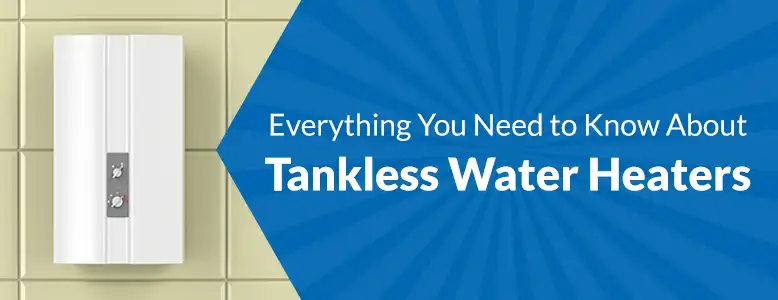
Warm running water is one of the most essential resources in any household. Whether you need to wash your hands, take a shower, run the dishwasher, or spin a load of laundry, you need to have an ongoing supply of warm and hot water.
The trouble is, a lot of homes throughout the United States have limited warm water supplies. The problem is most common in large households, where family members will often have to pause between turns in the shower and split loads of laundry across several afternoons. Granted, some families can manage this sort of discipline — but the limitations are stifling in most situations, especially when one of the following occurs:
- Shower lineups. If everyone needs a shower, yet the tank runs out of warm water after ten minutes, this can put a cramp on everyone's day — especially when everyone needs to get to work or school or make other important rendezvous.
- Dish pileups. If the yet-to-run dish cycle is too full for all the dirtied dishes in the sink and along the countertop, but there is only enough hot water for one cycle every few hours, the waiting period between dishwashing cycles can be quite inconvenient — especially if you have friends or family coming to visit.
If problems like these are common occurrences in your house, it’s time to consider a change in your water-heating system. Out with the old water heating tank and in with a new tankless water heater!
What Is a Tankless Water Heater?
The concept behind the tankless water heater is to heat water when activated, by you, to do so. You activate the heating process when you turn on your faucet to warm or hot positions. Generally, this is a more efficient option than the standard tank-based water heater, in which the water is heated continually regardless of whether you are asleep or out of your house for the day.
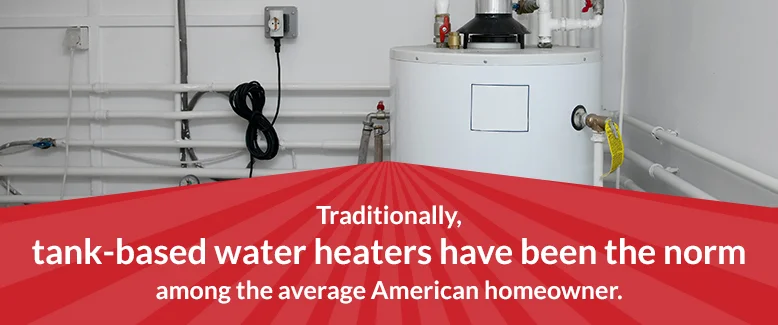
In the United States, the spread of tankless water heaters has been a relatively recent phenomenon. Traditionally, tank-based water heaters have been the norm among the average American homeowner. However, the growing environmental conscience of U.S. consumers has led to demands for green alternatives in the area of water heating.
In response to this newfound demand, U.S.-based manufacturers and dealers have looked to the solutions employed in other parts of the world. The answer to this wish for a greener water-heating solution has led to the stateside introduction of the tankless water heater, which has been standardized in Japan and across Europe for quite some time.
There are numerous factors that could make you a prime candidate for an upgrade to a tankless water heater, such as the following:
- An ailing tank heater. If your existing tank-based water heater is on its last legs of performance, it could be time to make the switch to a tankless water heater.
- High electrical and water bills. If your current electrical and water bills are too steep, a tankless water heater could help you drastically cut down both expenses.
- Carbon footprints. If you are weary of the greenhouse emissions that come from your gas-powered tank heater, the tankless alternative could significantly relieve you of those troubles.
- Space issues. If your current tank-based water heater has taken up too much space in your basement or garage — or if you simply wish to shorten the distance between the heat source and water outputs — a smaller tankless system could be the perfect answer.
- Not enough hot water. If you are dissatisfied with the amount of hot water your tank heater generates — the quantities of which can be inadequate in multi-party households — consider an alternative like propane or electric tankless water heaters that offer hot water on demand.
Truth be told, tankless water heaters generally cost more than their tank-based counterparts, but the savings you can reap in terms of water and electrical usage can recover the extra cost in due time. Therefore, when you decide to install a tankless water heater in your home, the outcome is generally a win-win as far as savings and convenience are concerned.
Another factor to consider is the longevity of one option over another. A tankless water heater will normally last anywhere from five to ten years longer than a traditional tank-based heater. As such, your purchase of a tankless water heater would amount to a more lasting investment — one that could possibly last for the remainder of the time that you occupy your current residence. This, too, can ultimately make up for the higher purchasing cost.
How Does a Tankless Water Heater Work?
The functions of a tankless water heater stand in marked contrast to that of a tank-based water heater. Simply put, the former heats incoming water while the latter holds an in-house water supply. In a tank heater, the water is heated continually both day and night — whether you have a faucet or washing machine running. The heat produced by the tank during these idle times is known as standby heat loss.
In a tankless system, there is no such thing as standby heat loss because water is only heated when you flip on a faucet or washing machine and set them to run at warm or hot temperatures. As such, tankless water heaters are alternately called "on-demand" units by certain dealers and advertisers. The lack of standby heat loss in tankless water heaters is the quality that makes units of this variety — be they propane or electric — more energy-efficient than tank-based water heaters.
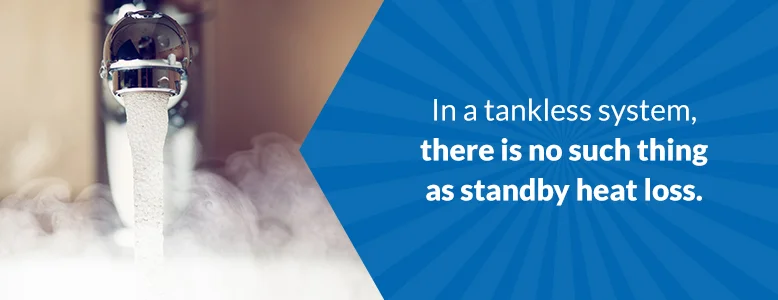
In a tankless system, the component that heats water on demand is known as a heat exchanger, which accesses heat from another source in order to raise the incoming water to a desired level of warmth. Heat exchangers are also contained in other devices and appliances designed to control temperatures, such as air conditioners, radiators, and refrigerators.
Depending on the type of tankless system in use, the heat exchanger consists of either electric coils or a propane-fueled burning component that heats water as it passes through. In a tankless water heating system, the functions of the heat exchanger work as follows:
- Activation. The heat exchanger is activated when you turn on your faucet to the warm or hot position or when you activate a hot washing cycle in your dishwasher or laundry machine.
- Heat. The activated heat exchanger warms the passing water to whichever preset temperature you have chosen.
The heating process is as simple as that. Once the heat exchanger activates on the passing water, all you need to do is lather up, whether you are washing your hands, taking a bath or shower, or washing dishes by hand.

A single tankless water heater could be enough for your entire house — or maybe just one or two outputs. It all depends on the size of your house and the type of system you choose. There are two types of tankless water heating systems:
- Point-of-use heaters. These are the smaller systems that are designed to handle a maximum of two outlets, such as a kitchen sink and dishwasher. Most point-of-use heaters are of the electric variety.
- Whole-house heaters. These systems are designed to handle all the water outlets in a house — kitchen, bathroom(s) and laundry room. Whole-house heaters are usually fueled with either gas or propane.
Though it might seem that a whole-house heater would be the obvious choice for a sizable household, a lot of homeowners prefer to have several localized point-of-use heaters. This is due to the compactness of point-of-use heaters, which makes it possible to situate them in small spaces — usually a lot closer to a given output than would be possible with a whole-house heater.
For example, point-of-use heaters are typically installed in the cabinets under kitchen and bathroom sinks and in closets adjacent to laundry machines.
The proximity of these smaller tankless systems reduces the issue of lag time, which is defined as the amount of time it takes for heated water to reach its endpoint. For obvious reasons, warm water generated through a whole-house heater in the basement will be subjected to a significantly longer lag time — in some cases several minutes — than warm water generated through a point-of-use heater directly below the sink.
Aside from the issue of diluted water warmth, the lag time can ultimately lead to wasteful water consumption and excess electrical drainage. After all, if the desired temperature is lost in the time it takes for the heated water to flow from your basement to the second-floor bathtub, you are likely to set the temperature of your tankless system even higher to compensate.
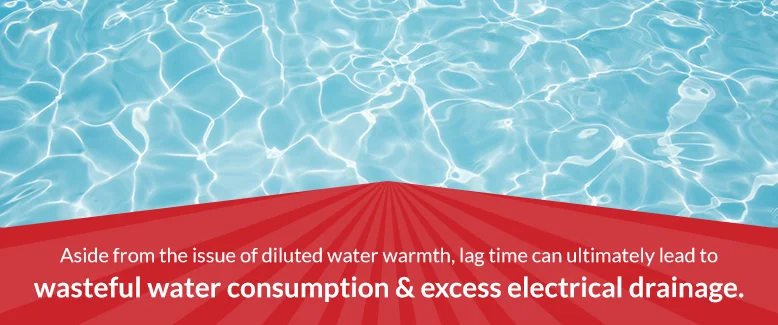
Nonetheless, there are factors that lead some homeowners to opt for a whole-house heater over one or more point-of-use units. Your ultimate preference could depend on whether you prefer electricity over propane and vice versa, and whether your house is small enough to have a larger tankless system with no major issues regarding lag time.
Pros and Cons of a Tankless Water Heater
There are many benefits that come with propane and electric tankless water heaters, which are generally more durable, efficient and easier to maintain and operate — in a broader variety of living quarters — than tank-based water heaters. Granted, tank-based heaters also have some disadvantages, but the cons are often conditional and depend on whether you go with a propane or electric unit.
Tankless Water Heater Pros
- Tax rebate. A majority of tankless water heaters come with a $300 federal tax rebate. As such, there is a financial incentive to choose a tankless water heater over more conventional options.
- Unlimited hot water. A propane or electric tankless water heater will never leave you with a shortage of hot water. If you live in a large household, there is no need to wait between taking turns in the shower because the hot water supply never runs low.
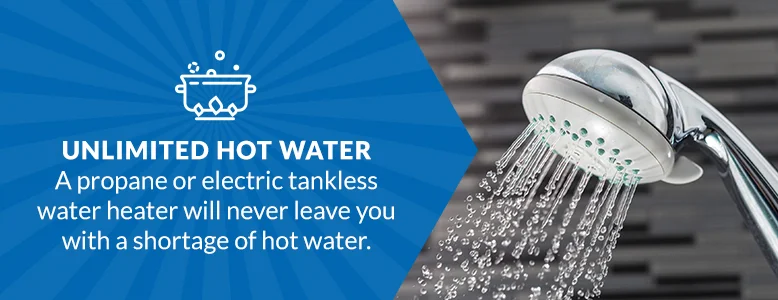
- Longer life. Tankless water heaters are generally more durable than heaters of the tank-based variety. On average, an electric or propane tankless water heater will last anywhere from five to ten years longer than a tank water heater.
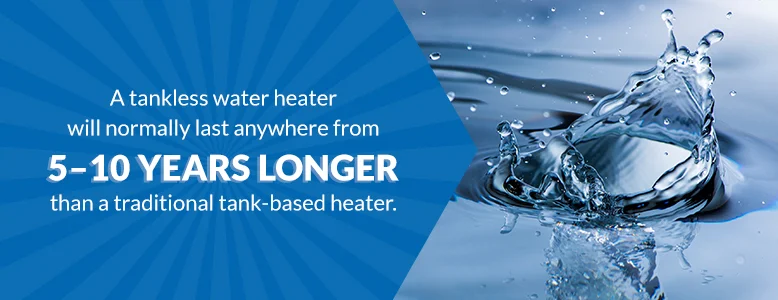
- Greater efficiency. Due to the fact that tankless water heaters do not heat water on an ongoing basis when the water is not in use, you can get much greater energy efficiency with a tankless water heater, which will only produce heat when you need warm or hot water.
- Compact size. Tankless water heaters generally take up less space than conventional, tank-based water heaters. The compact size can make things especially convenient if you choose to get a separate tankless heater for each of your sinks, showers and washers.
- Fit anywhere. Whereas tank-based water heaters are typically placed in the basement, a tankless water heater can be placed anywhere around the house. Thanks to the compact size of most tankless water heaters, they can be placed closer to their points of use. You can place one under your kitchen sink, one in your bathroom, and one in your laundry room.
- Heat as needed. With a propane or electric tankless water heater, power is only consumed when you run a faucet and turn up the water heat. As such, power is consumed far more economically with a tankless heater than with heaters of the tank-based variety, which constantly heat water even when no water is in use.
- Lower heating bills. Due to the fact that the tankless water heater, unlike its tank-based counterpart, only heats water when a faucet is turned on to warm or hot positions, you can save significantly on your monthly energy bills with a gas or electric tankless water heater.
- Environmentally friendly. An electric tankless water heater will not emit greenhouse gases. As such, electric tankless water heaters are much friendlier to the environment than all the other options — especially more so than tank-based water heaters.
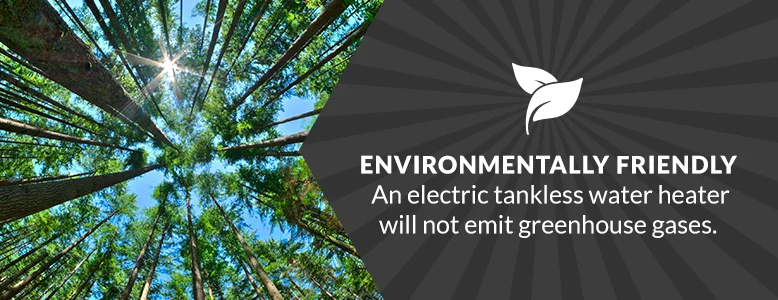
- Remote-operated. A majority of tankless water heaters operate via remote control, which makes them easier to command. Furthermore, most models are equipped with up to four remote settings, which gives you more options when it comes to choosing a desired temperature for the time of year and the area where you live.
- Flood-safe. A tankless water heater is incapable of causing any sort of flood within your living quarters. In contrast, a tank-based water heater could possibly flood your basement or floor if a rupture forms in the tank body or connected piping.
Tankless Water Heater Cons
- Higher upfront cost. The price for a tankless water heater is typically three times that of a tank-based model. However, the initial asking price of a tankless heater can generally be earned back in due time thanks to reduced energy consumption.
- Split output. The hot water generated by a tankless heater is split between all the outputs in your house. Therefore, if two or more washing machines and/or tubs are run at the same time, none get the maximum supply of heat. As such, your shower could be rendered lukewarm if you run the dishwasher simultaneously. However, this problem can be avoided if you purchase a separate tankless water heater for each output.
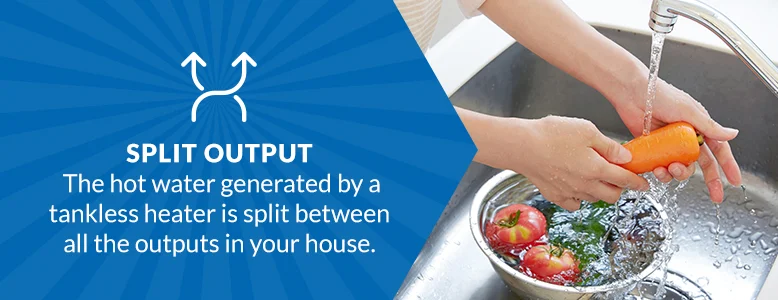
- Possible gas-line replacement. If you opt for a gas tankless water heater, you might need to have your pre-existing gas line replaced with a larger line in order to adequately fuel the new heater.
- Steel tubing is required (gas/propane models only). In order to properly vent a gas or propane tankless water heater, you must have stainless steel tubing, which could add to the expense of the installation if no such tubing exists in your house.
- The possible extra circuit is needed. In order to run certain electric models of tankless heaters, you might need an additional electric circuit.
- Greenhouse gas emissions. Gas and propane tankless water heaters contribute to greenhouse gas emissions. Granted, this only occurs when the faucets are running at warm and hot levels — unlike tank-based water heaters, which constantly require electricity.
- Required annual servicing (gas units only). A gas tankless water heater must be serviced on an annual basis, which adds a minor secondary expense to the operation of gas units.
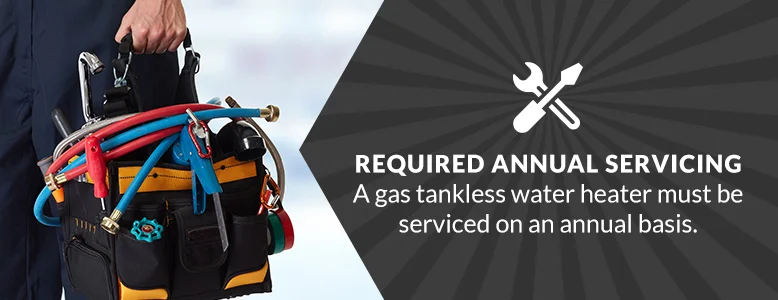
- High energy consumption (electric units only). Electric tankless water heaters need high levels of energy in order to run. By contrast, gas and propane tankless water heaters require no electricity.
- Required minimum flow rate. In order for the heat exchanger — the system part that warms the water — to activate, a tankless water heater must have a 0.5 GPM minimum flow rate.
- Lag time. Often, in order to get the water heated to a desired temperature, you need to run the water for a minute or more with a tankless heater. Consequently, this can result in water waste.
Additional things to consider about tankless water heaters include the following:
- In a breakdown of home electricity costs, water heating generally accounts for 20 percent.
- It generally costs less to install a tankless water heater of the electric variety.
- Natural gas costs less than electricity, but this is liable to reverse in the years ahead.
- Roughly 35 gallons of hot water are consumed during the average bath, while anywhere from 45 to 80 gallons are needed to fill a soaking tub.

If your current tank-based water heater is due for a replacement and you are mulling whether to upgrade to a propane or electric tankless water heater, compare the Energy Guide sticker on a prospective tankless model with the sticker on your pre-existing unit. This sticker on the new model should shine some light on what to expect if you make the switch.
As an overall more advanced type of heater, an upgrade to a tankless model will generally cost more than a simple replacement of your pre-existing heat tank. However, you can soon make back that difference through the monthly savings that tankless units provide. To determine how long it will take to recoup your investment, perform the following simple math steps:
- Add up purchase and installation costs. Add up the cost of the tankless unit and the various expenses that accompany the installation process, including venting costs and any needed electrical or gas-line upgrades.
- Subtract monthly savings from the startup sum. As soon as you have the total for these startup costs, subtract your monthly savings — the money you will save month-to-month by switching from tank-based to tankless water heating — from the startup total.
Eventually, the savings will eat the last dollar of the startup sum and you will then have the investment recouped. At this point, you simply proceed to save money with your tankless water heater. The time it takes to reach this point is referred to as the payback period.
Furthermore, consider the longer lifespan of tankless heaters in comparison to heat tanks. The former last anywhere from 15 to 20 years, whereas the latter typically expires after a decade. The savings that you accrue over the following two decades are sure to be consequential.
What Size Tankless Water Heater Do I Need?
In order to determine the optimal size of tankless water heater for your home, you must first understand how factors like size, water demand and heating capability combine to give a tankless unit its power. The breakdown is best described as follows:
- Size. The size of a tankless water heater correlates to its rating.
- Rating. The rating of a tankless water heater is determined by the amount of heat the unit is capable of generating in relation to a given volume of passing water.
- Flow rate. The amount of water that passes through a given output per minute is known as the flow rate.
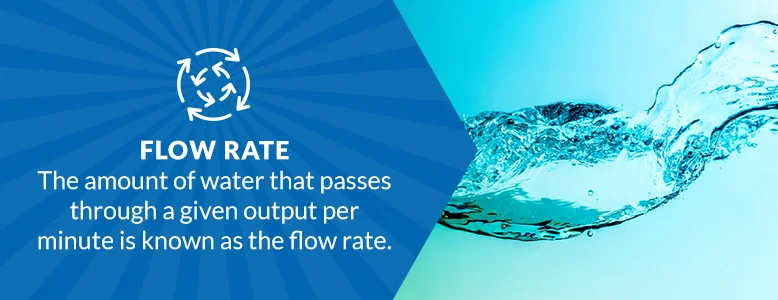
Therefore, in order to decide on the best tankless water heater for your house, you must know which unit size is capable of heating the combined flow rate of all the outputs that you plan to connect to the heater. It must be stressed that you should never settle for a heater below your size needs in the hopes of saving money on the purchase of a tankless water heater.
The process of finding the most properly sized tankless heater for your house involves several steps, the first of which can be broken down as follows:
- Count the outputs. Determine how many water outputs you intend to connect to the tankless heater. Do you intend for this tankless unit to heat the water for all the outputs throughout your house, or is this heater only intended for the outputs in your kitchen or bathroom?
- Determine the collective flow rate. Add the desired flow rates of all the outputs you intend to connect to this tankless water heater. The flow rates could vary per output. For example, you might wish to run your bathroom sink at a flow rate of 0.70 gallons of water per minute, but run your shower at a flow rate of 2.5 gallons per minute.
While you might not imagine your bathroom sink and shower being used simultaneously, the possibility must be factored into the range of demands that a tankless heater should accommodate. Therefore, the combined flow rates of both outputs must be exceeded by the rating of whichever tankless system you purchase.
According to the preceding example, the flow rate for your prospective tank would need to be at or above 3.2 gallons per minute to fulfill the hot water expectations of the bathroom sink and shower. If your eyes are set on a point-of-use heater for your bathroom alone, a flow rate of 3.2 or more would suffice for a 0.70 sink and 2.5 shower. If you intend to connect other rooms or fixtures, you'll need to adjust the collective flow rate to account for the additional outputs.
The next step is to determine the necessary temperature rise for your water heating system. The temperature rise is the difference between the natural temperature of your incoming water and the desired temperature when you turn a faucet to its hottest position. To determine the temperature rise, perform the following two steps:
- Note the temperature of incoming water. With your faucet in the neutral position — where the handle faces to the center of the sink — fill a glass with water. Use a thermostat to take the temperature of the water. Whether you get 45° F or 55° F, the natural temperature of your incoming water is liable to match the average annual outdoor temperature in your area.
- Determine your desired hottest temperature. In sinks and showers, the temperature of hot water should peak in the region of 115° F to 120° F. For showers and hand-washing, people generally prefer a water temperature of 105° F, but for maximum options, it is best to set the limit somewhat higher.
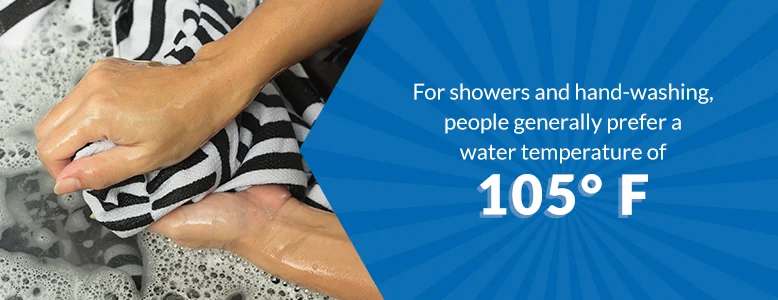
- Subtract the first temperature from the second. Subtract the natural water temperature from the desired temperature of the water at its hottest. If the natural temperature of your water is 48° F and you want the faucets to produce water temperatures as high as 115° F, the required temperature rise for your tankless heater will be 67° F.
Not all measurements of natural water temperature are accurate, but it never hurts to assume a lower-than-accurate figure. If you wind up with an odd-numbered temperature rise, round off the figure to the nearest higher number accommodated by the tankless units that you preview.
For a better understanding of how to properly size a tankless heater for the needs of your water outputs, consider a more complex example in which two sinks and two showers must be connected to the heater. What would be the necessary temperature rise and flow rate for the simultaneous use of all four outputs if the following factors are in play?
- The natural water temperature in your home is 40° F.
- Each sink uses 0.8 gallons of water per minute.
- Each shower uses 2.7 gallons of water per minute.
Assuming that 105° F is the preferred showering temperature among members of your household, you would need the tankless water heater to yield a temperature rise of at least 65° F at a flow rate of at least 7.0 gallons per minute.
The chart below represents the average flow rate — gallons per minute (GPM) — and most commonly desired temperatures for the following household fixtures:
- Sink. 1.5 GPM | 110° F
- Shower. 2.5 – 3.0 GPM | 104° F
- Tub. 4.0 GPM | 102° F
- Dishwasher. 1.5 GPM | 110° F
- Washing machine. 2.0 GPM | 120° F
Gas and propane units generally offer more immediate levels of heating power than tankless water heaters. As such, gas and propane are most often used in whole-house tankless systems.
Installing a Tankless Water Heater
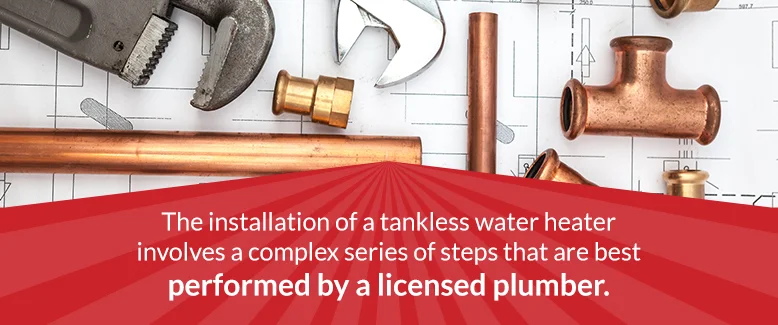
The installation of a tankless water heater involves a complex series of steps that are best performed by a licensed plumber. That said, tankless heater installation can be a DIY undertaking, though this should only be attempted by people who have experience with complex home improvement plumbing projects. Before the project begins, the following tools and bonding products are essential:
- Drill
- Hacksaw
- Propane torch
- Reciprocating saw
- Screwdrivers
- Silicone caulk
- Spade bit
- Wrenches
In addition to the tankless water heater, a number of connecting parts and supporting materials are also necessary. If the heater in question is of the propane variety, you will need the following:
- 2 x 4 board
- Black pipe
- Copper pipe
- Flux
- Gas supply line
- Pipe insulation
- Stainless steel vent pipe
Step 1. Disconnect your pre-existing water heater. Turn off the heater and disconnect its gas supply. Drain any remaining water from the tank. If the tank is located in the spot that you intend for your new tankless heater, remove the old unit. Otherwise, leave it alone for now.
Step 2. Replace or upgrade the gas line. If necessary, add a tee and valve to your pre-existing gas line. Install a black pipe or gas-supply line between the tee and the attachment point of the tankless heater gas line.
Step 3. Install the water lines. With copper pipes, attach the lines for hot and cold water to their corresponding points on the tankless heater. For better control of the pipes during this step, use bell hangers. Make sure the pipes are cleaned of oxidation in advance of soldering. With flux applied to the end of the pipes, join them with the connectors and solder them together.
Step 4. Mount the new tankless water heater. A propane tankless water heater should be placed about four inches from the wall, preferably in an area with outside ventilation. Lay down a piece of 2 x 4 lumber on which to mount the heater. Make sure the heater is secure and balanced in its place.
Step 5. Connect the tankless water heater. As instructed by the owner's manual, connect the sediment trap and shutoff valve to the new heater. Link the gas supply line at the shutoff valve. Join the water supply line to its corresponding point on the water heater. Power the gas to test for leaks, then turn the gas back off until the installation is finished.
Step 6. Install the vent. The installation part involves a complex series of steps:
- For heat resistance, apply silicone sealant to the heater vent shaft and then attach the connector and secure it tightly.
- Connect the vent pipes and secure them into place with a retaining ring.
- Attach an elbow in the direction that will point the ventilation toward the outside.
- Drill a vent hole between the wall and the outside.
- Connect the water supply line and tankless heater.
- Remove any shingles along the exterior that might obstruct the vent hole.
- Caulk the flange along the edge, then place the flange into the vent hole. Tightly screw and seal to the outside wall.
- Install the interior flange and connect the vent pipe to the opening of the flange.
- Outside, connect the vent pipe and vent hood.
Step 7. Activate your new tankless water heater. With the installation complete, plug the heater power cord into the nearest outlet. Turn on the hot water of an attached output to feel the results. For best results, make sure the hot water pipe that connects the heater to the output fixture is insulated.
Various external factors — such as local climates and building codes — must be taken into account with the installation of a tankless water heater. Additionally, you must be mindful of safety issues — especially if you install a gas or propane water heater. Once an installation has been completed, be sure to perform periodic maintenance to keep the heater in optimal condition for the full run of its 15-to-20-year life expectancy.
Contact Mr. Rooter Plumbing of Greater Syracuse

For nearly five decades, Mr. Rooter has been the nation's most trusted name in plumbing and water heater installation. Whether you need routine maintenance, piping repairs or an overall change-out of your kitchen/bathroom water-heating and piping systems, our specially trained and licensed plumbers are only a phone call away. We can even help you select your new tankless water heater.
For plumbing and repairs, or for the installation of a new tankless water heater, contact Mr. Rooter Plumbing of Greater Syracuse today.

